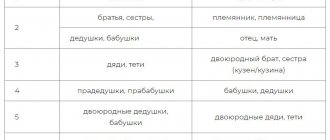Man is a social being: interpersonal connections and the unification of people into various types of groups speak about this. People get married, give birth to children, and enter into special relationships called kinship. There are blood and social types of kinship. Family ties can be close or distant. The distance between relatives determines the degree of relationship. Who is who and who is related to whom? How to build a family tree and understand the intricacies of family relationships? You will find answers to these and other questions in our article.
Who are blood relatives?
Consanguinity is otherwise called biological or natural. There are several options:
- Direct kinship is established between relatives descended from each other, this is a parent and a child, for example, a mother and daughter.
- If several people are united by a common ancestor, then such a relationship is recognized as lateral.
- Two common parents are a sign of a full-blooded relationship, that is, this is a family relationship between the children of one married couple.
- A person who has the same parent in common with you can be considered a half-blood relative. Unfortunately, sometimes families break up, but after a divorce, people can remarry, and new children may appear. For example, if you have a common mother, and her daughter will be your half-sister, and her son will be your half-brother.
Close relatives in NK
This term in tax legislation is considered from the point of view of various transactions, exemption from payment of tax duties and fees. Article 217 of the Tax Code states that any gifts received from close relatives are not taxed. They are also not indicated in the income tax return.
When donating real estate by close relatives, both parties are exempt from paying a one-time tax. This is justified because the giver does not receive a benefit, just as the recipient does not pay a fee for the gift. Moreover, if a real estate purchase and sale transaction is concluded between close relatives, the buyer can receive a tax deduction for the property. The seller, in turn, must submit a personal income tax return to the tax authorities.
Spouses who are not considered close relatives are treated as such in cases of giving expensive gifts to each other.
Types of social kinship
When a man and woman get married, they create a new family. By registering their relationship, they bind themselves by marriage. If children are born to them, blood ties are established with them, but they remain socially related to each other. The relatives of the spouses have the same relationships among themselves: mother-in-law, father-in-law, son-in-law, mother-in-law, father-in-law, daughter-in-law - all these are relatives of a social nature.
Another type of social kinship is adoption.
In Christian families, religious ties between godparents, godmothers and godchildren are also considered social kinship.
Relatives near and far
Why are some relatives considered close and others distant? What connections unite people in a family? In order to determine the distance between members of the same family, there is such a thing as the degree of relationship. This situation is difficult to explain with any scientific definition and is much easier to explain in a specific situation. In simple terms, this is the connection of one person with another through birth. The more births between these individuals, the greater the degree of relationship. Here are some examples:
- A woman and the boy born to her are connected by one birth, which means that mother and son are a primary connection.
- Grandmother and granddaughter are connected by two births, therefore, there is a second degree of relationship between them.
Proof of relationship upon allocation
A person can draw up a will, according to which the inheritance is transferred according to his will, and not only immediate relatives can be heirs. Such a will can be challenged, but to do this you need to have evidence of the degree of relationship with the testator. If you happen to be one of the heirs, then you should know that the order of inheritance is determined by the Civil Code of the Russian Federation.
By bequeathing property to direct heirs - children, you can be sure that they will not have problems with its registration. If the will is made in favor of a person who is not a relative, then blood ties do not need to be confirmed. A certificate confirming the right of inheritance is issued in this case without determining the degree of relationship.
Situations often arise when it is necessary to confirm blood relationship. According to the law, children are the primary heirs. Sometimes it turns out that the deceased has illegitimate children who also have priority inheritance rights. Evidence can be either documents, such as a birth certificate, or oral testimony. The notary checks documents on kinship and identifies the heir. In cases where there are no documents confirming the degree of relationship, children may be included in the certificate of inheritance with the consent of other persons who have such evidence.
It is much more difficult to prove the relationship of subsequent degrees. You can confirm that you are the brother or sister of the deceased on the basis of issued birth certificates, which indicate the first name, last name and patronymic of your common parents. Other relatives also have to seek confirmation in the registry office archives, making written requests, and collect testimony from common relatives.
How to write a questionnaire about the degree of relationship?
When getting a job, applying for a loan, joining the service and in a number of other cases, people fill out forms indicating family members, and they may also need the degree of relationship (family ties are presented in the tables in the article). To write correctly you need:
- Determine the closeness of relationship.
- Indicate the status of the relative, for example, ex-wife, widower, etc.
- Indicate personal data, namely surname and initials, place of residence, position, etc. upon request.
An official form of relationship is required: mother, father, cousin, etc. All data must be current at the time of submitting the application. If they have changed, for example, the last name, then it is advisable to note this. All dates, places of birth and residence are indicated based on passport data. If the person filling out the form does not have information about a relative, the following wording must be written: “I have no information about such and such.”
Do not be negligent in filling out the column about immediate relatives. As a rule, it is checked with special care by higher authorities and the management of the organization and may affect the decision-making process regarding the person submitting the questionnaire.
Who's Who: Kinship Terminology
What do people become to each other when they acquire family ties? Let's try to figure it out, starting with the simplest. Who are the blood relatives?
When a man has children, he becomes their father, and a woman in this case acquires the status of a mother. Both of them can be called by the general term - parents. A male child born is a son for them, a girl is a daughter, both of them are children. A boy in relation to other children of his father and mother is called a brother, a girl in a similar case is called a sister. The parents of the father and mother are grandparents, and the children of the son or daughter are the grandson or granddaughter. To further generations the prefix “great-” is added, and relatives are called great-grandparents, great-grandmothers, great-grandchildren and great-granddaughters.
These connections are simple and understandable to every person. The situation is more complicated with blood relatives not in a direct line. Children of sisters and brothers are cousins in relation to each other, children of cousins are second cousins, and so on. Your mother's or father's brother will be your uncle, and your sister will be your aunt.
Relationship table
The easiest way to understand the location of people is in a table. When a child is born, he immediately receives a large number of relatives.
The baby will be taken as the starting point, connections will be indicated in the masculine gender:
| Relation degree | Who's for the baby | How does kinship work? | What will the name of the child be for this person? |
| First | Parents | Directly | Son or daughter |
| Second | Brothers, grandfathers | Through parents | Brother, grandson |
| Third | Uncles | Parent – his parents (grandparents) | Nephew |
| Fourth | Great-grandparents | Parent – grandfather – his parents (great-grandparents) | Great-grandson |
| Fifth | Great uncles | Parent – grandfather – great-grandfather – their second child | cousin grandson |
| Sixth | Great uncles or cousins | In the first case, the relationship comes from great-uncles, in the second - through an uncle’s cousin | Great cousin |
Please note: the child’s spouse will “join” the first step.
New family - new relatives
Even more confusion arises in relationships through marriage. By creating a family, a man and a woman become spouses, being husband and wife to each other. The husband's father and mother are called father-in-law and mother-in-law, and the wife's parents are called father-in-law and mother-in-law. In relation to the parents of the spouses, the married couple are called son-in-law and daughter-in-law (daughter-in-law). The parents of the husband and wife are each other's matchmakers.
In the person of her husband's brother and sister, a woman acquires a brother-in-law and sister-in-law, and the wife's brother and sister become a brother-in-law and sister-in-law for a man.
In-law relationships
In legislation, in addition to blood relationship, there is another type of relationship. This is our own relationship. They are the only type of kinship that is based not on blood ties, but on the fact of marriage. Let us explain in more detail.
People who officially register a relationship become close relatives. The following situation arises. Family members on both sides can be called distant relatives based on their relationship. The basis for this in a particular case is a marriage certificate. In this case, obligations towards each other are borne exclusively by spouses.
Simply put, a husband legally does not have to take care of his mother-in-law, just as a wife does not have to take care of her mother-in-law. In the event of a divorce, the spouses lose their relationship. The only obligations that unite former spouses relate to the upbringing and financial support of children, if any.
How to make a pedigree chart?
First you need to collect as much information as possible about relatives and your family. It happens that people do not know who their grandfathers and great-grandfathers were. This situation arises when a newly created family arises far from the places where the ancestors lived. You can ask your parents or other older family members for this information. With the information you need, you can begin to create your family tree.
First of all, indicate your name. It is better to position it so that there is room for everyone else around it. It will be most convenient to occupy the top of the sheet approximately in the middle. If you have children and grandchildren, step back a little at the top, leaving room for them. By depicting relatives on the diagram, you will sink lower and lower to your roots - your ancestors. You can place your name at the bottom of the sheet, then the branches will diverge upward.
The second step is to locate the parents with whom you are first degree related in the family tree. Write their names above or below your cell, and connect them to yourself by drawing arrows or lines to them. These are your closest relatives. If you have more than two parents, enter them all. Your stepmother or stepfather will be reflected on the same level as your blood father and mother.
After this, place your blood and half-brothers and sisters next to you, on the same level as your name, also linking them to your parents. If they have wives, husbands or children, you can include them too. Spouses' names are placed next to each other, and children's names are placed above or below, depending on the direction you choose. Connect them with lines.
At the next level, indicate the parents of your father and mother, that is, your grandparents. From them, arrows will return to the previous level, leading to the names of the brothers or sisters of your mother or father, who are your aunts and uncles and are on the same level as your parents. Their wives and husbands will be listed next to them, and their children will be on the same level as you, since these are your cousins.
Continue filling out the tree, sequentially including relatives you know, until you have placed everyone.
Advantages of computer family tree
In our mobile age, filled with computers, it is not at all necessary to draw a family tree with pen and paper; you can entrust this to special programs for creating a family tree. There are many similar products, some of them are distributed completely free of charge.
Such a program is capable of attaching not only photos, but also video and audio recordings; it can search the Internet for matches by places, dates, events - your family tree may have data in common with other people’s patterns. A profile is added to each family member, where you can enter anything - from a description of appearance, contact information and documents to interesting facts from the biography. The programs are easy to use and understandable even for inexperienced users. In addition, they are equipped with prompts that help you fill out information correctly and enter data.
The pedigree can be displayed in the program as a table, in which the degree of relationship is reflected verbally, or as a diagram, where the connections are expressed graphically.
Almost all programs have a print option. It is needed in order to transfer your creation from an electronic version to a paper one. Some programs offer several design templates to choose from. By choosing one of them, you can make your family tree not only informative, but also visually attractive.
Among such programs, the most popular are products from foreign developers such as GenoPro, GRAMPS, RootsMagic, SimTree, Family Tree Builder. There is also a Russian analogue - the Tree of Life program.
Relationship from a legal point of view
Legislation defines special family ties in the legal system and establishes a number of restrictions or relaxations. Each code characterizes the degree of kinship in a family in its own way. In practice it looks like this. If the IC calls one group of people relatives and, by its definition, shares the degree of kinship, then for the IC this is a completely different category of persons.
In legal institutions, this term often appears in civil, criminal, family and tax codes. However, the law does not provide for an unambiguous list of close and distant relatives.
In each individual case, kinship, from a legal point of view, has its own specific meaning. For example, when inheriting property, mandatory applicants are taken into account first, and when dividing property between spouses, minor children are also considered. In criminal law, close relatives have the right to refuse to testify against each other.










